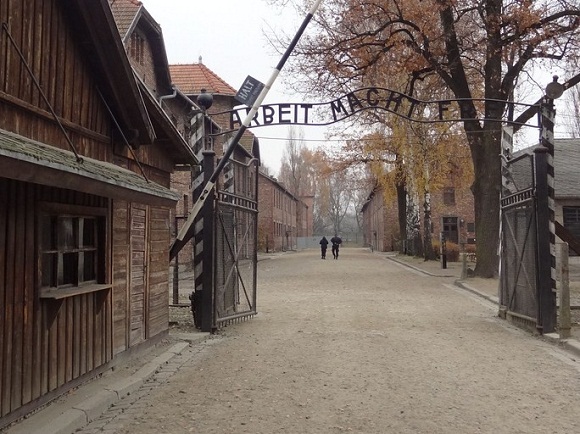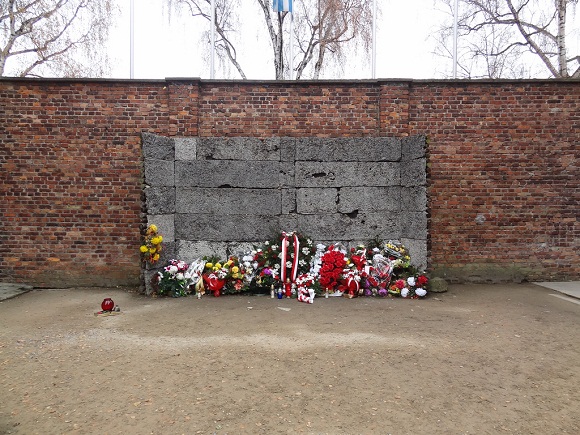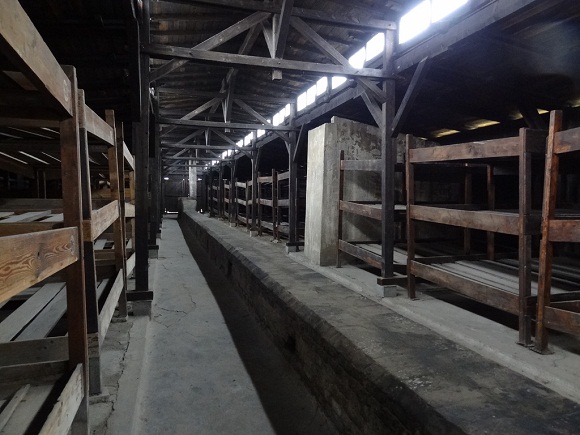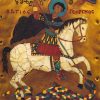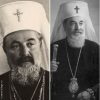“Monsters exist, but they are too few in number to be truly dangerous. More dangerous are the common men, the functionaries ready to believe and act without asking questions….”
–Primo Levi, survivor of Auschwitz, If This is a Man
No one is certain how many died at Auschwitz. Most prisoners were gassed soon after arrival without having been registered, while, for those who were registered, the SS destroyed the bulk of their records before abandoning the camp. But years of research have shown that the figure is not less than 1.1 million people. Even that minimum figure leaves us with a number beyond comprehension. One million plus one hundred thousand. In the summer months, there are perhaps that many leaves on the trees in the park where I take a walk each morning before starting work. I live in a city of one hundred thousand people—thus the number killed equals everyone in this city plus ten more of the same size. But in fact there is no way to envision such a number meaningfully. I cannot take it in.
The way we usually deal with so large a number of human casualties is to focus on just a single face. One face, one story. This is manageable. A single life and death can open a window on a vast crowd.
The most well known face of the Holocaust is Anne Frank, who was fifteen when she and her family arrived at Auschwitz. (From there she was transferred to Bergen- Belsen, where she died.) It is consoling to know that her diary has been read or seen enacted in film or on stage by far more people than died in all the Nazi concentration camps combined. Millions have visited her hiding place in Amsterdam. In July 1944, shortly before she and her family were taken away, she wrote in her diary, “I hear the approaching thunder that, one day, will destroy us too, I feel the suffering of millions. And yet, when I look up at the sky, I somehow feel that this cruelty too shall end, that peace and tranquility will return once more.”
Or there is the face of Etty Hillesum, a young Jewish scholar who wrote another widely-read diary of life in Amsterdam during the German occupation, in her case lived in the open. Turning down offers to go into hiding, she explained to friends that she wished to share her family’s and her people’s fate. She died at Auschwitz on the last day of November 1943. “They [the Nazis] are out to destroy us completely,” she wrote in her diary. “We must accept that and go on from there…. Very well then … I accept it…. God, take me by Your Hand. I shall follow You faithfully, and not resist too much. I shall evade none of the tempests life has in store for me, I shall try to face it all as best I can. I shall try to spread some of my warmth, of my genuine love for others, wherever I go…. I know that a new and kinder day will come. I would so much like to live on, if only to express all the love I carry within me. And there is only one way of preparing for the new age, by living it, even now, in our hearts.”
Or it could be the face of Edith Stein, a nun with Jewish roots whose life ended on the 9th of August 1942 in a gas chamber at Auschwitz. She had been born in Poland, had lived in Germany and was in a Dutch Carmelite convent at the time of her arrest. “I told our Lord,” she wrote, “that I knew it was His cross that was now being placed upon the Jewish people; that most of them did not understand this, but that those who did would have to take it up willingly in the name of all. I would do that. At the end of the service, I was certain that I had been heard. But what this carrying of the cross was to consist in, that I did not yet know.”
For me, living in the Dutch city of Alkmaar, there is another way of making an intimate connection. On the 5th of March 1942, 213 Alkmaar Jews—all the local Jews not in hiding—were gathered at our one synagogue and from there transported, via Amsterdam and Westerbork, to Auschwitz. Only a few survived. (Today, after a 69-year recess, the same synagogue has just been restored and reconsecrated.)
So many names, so many stories, so many faces to choose from. More than a million.
It had long been a hope of mine to visit this Golgotha of the modern world. Though far from the only one, Auschwitz provides the most vivid image of the assembly-line production of dead bodies—a factory of absolute nihilism, a revelation of a demonic longing to assassinate God and the divine image in man.
The chance to visit Auschwitz finally came, thanks to an invitation to give a lecture at an interfaith peace conference at the University of Wroclaw in Poland. My topic at the conference was not a theory of dialogue but the story of a rescuer—Mother Maria Skobtsova, now recognized as St. Maria of Paris, who founded a house of hospitality in Paris where many lives were saved before she and her principal collaborators were arrested. Mother Maria’s life ended at Ravensbrück concentration camp in Germany on the eve of Easter 1945. I could think of no better way to contribute to an interfaith meeting than to tell the story of a Christian willing to lay down her life for Jews.
I was one of three Orthodox Christians from outside Poland who came to the conference. The other two were Metropolitan Kallistos Ware, from Oxford, and Archimandrite Ignatios Stavropoulos, from a monastery near Nefpaktos in Greece. With us was Father Vladimir Misijuk, an Orthodox priest who has translated several of Metropolitan Kallistos’ books into Polish, and Dr. Pawel Wroblewski, one of the prime movers behind the peace conference in Wroclaw.
The day after the conference ended, we traveled together to the camp, now the Auschwitz-Birkenau State Museum.
The local weather seemed to be in mourning—chilly, gray, on the edge of foggy. The area for miles and miles around Auschwitz is flat and thinly populated. The town near the camp, Oswiecim, is almost entirely of post-war construction—the population had been removed by the Germans before construction of the concentration camp was started so that there would to be no local witnesses.
Standing near the only surviving crematorium, our delegation was met by a historian on the museum staff, Teresa Wontor-Cichy, who led us under the camp’s notorious Arbeit Macht Frei sign—Labor Brings Freedom. It was here that the famous Auschwitz inmate orchestra played as columns of famished prisoners marched in and out twice a day to their places of labor. The music, Teresa told us, made it easier for the guards to count.
I had imagined Auschwitz-Birkenau as one inter-connected camp, but soon learned that Auschwitz served as the nucleus for more than forty other camps, with nearby Birkenau the point of delivery for the daily trainloads of prisoners, mainly Jews but also Christians, gypsies, homosexuals, and political opponents of the Nazis.
In Auschwitz itself, nearly all the buildings had been constructed of brick. It could pass for a solidly-built military post. It would not have been hard to convince a naive visitor, so long as he didn’t look behind the wrong doors, that the conditions of life at Auschwitz weren’t so bad. Why, there was even an orchestra! On the other hand, were a visitor to be taken inside the buildings, he would have soon discovered that there are hells in this world worse than any hell he might imagine in the next. For example, there was Block 10—the domain of Nazi doctors carrying out the most vile medical experiments. One of the physicians, Josef Mengele, became known as the “Angel of Death.” Block 11 served as a “prison within the prison.” A small court operated here at which many were sentenced to death. The basement cells were for those deprived of all food and water. Among ten men sent to die in one such cell, now marked by a tall Paschal candle, was Maximilian Kolbe, who volunteered to take the place of a young husband and father. Kolbe was the last to die, enduring two weeks of starvation, thirst, and neglect. He has since been canonized by the Catholic Church.
We stopped for a time in the yard between Blocks 10 and 11. This had been used as a place of summary execution for those convicted of breaking camp rules. Even a baseless accusation could mean death before a firing squad. Here Metropolitan Kallistos led us in a prayer, long silences between each phrase, both for those who died here and for the guards who had caused so much suffering. We prayed with the awareness that, while the Nazis themselves despised Christianity, centuries of Christian anti-Semitism had helped create an environment of contempt and hatred without which the Shoah would have been impossible.
The charts, maps, and photos we saw in the various buildings we passed through effectively told the story of the creation and uses of Auschwitz and its surrounding network of camps, but what made the deepest impression were the many items the SS had failed to destroy as, the Red Army fast approaching, they made their hurried retreat in January 1945. We passed through room after room containing the mute evidence of people who, after stripping naked for a delousing shower (so they were told), were gassed by the hundreds at a time—all children younger than fifteen, their mothers, the elderly, those judged unfit. Among those condemned on arrival, the lucky ones were those closest to the shower heads—they died immediately—while those further away took upto twenty minutes to breathe their last.
Even as they were dying, their possessions were being carefully sorted. We saw a mountain range of shoes, thousands of reading glasses, the train tickets more affluent passengers had purchased for the privilege of riding to Auschwitz first or second class instead of traveling in freight cars, and countless suitcases bearing names and addresses of the doomed. We saw dense piles of hair that had been cut from the bodies of women after they were removed from the gas chamber. The hair was for use, Teresa told us, as a commercial component in making textiles. Finally we saw empty canisters of Zyklon B, the substance from which the lethal cyanide gas was released.
Our final stop in the original Auschwitz was the camp’s one surviving place of gassing and body burning. It had escaped destruction because, when much larger gas chambers and crematoria were built at Birkenau, this smaller building had been converted into a bomb shelter. The adjacent crematorium, with its tall square chimney and just two ovens, was also left intact.
Birkenau, about a mile away, didn’t bother with brick structures for housing its captives. It was a gridiron of quickly-erected wooden barracks filling a vast area, barrack after barrack as far as the eye could see. Though a small number of barracks survive, in most cases only the foundations remain. The one brick building left standing is at the entrance to Birkenau, a one-storey structure crowned with an observation tower in the center under which prisoner-bearing freight trains arrived from every part of Europe. A few hundred yards beyond the station, truly the end of the line, was the area where an SS doctor presided over the selection process. Some were judged healthy enough to work—a slow death-sentence for all but a few—while the rest were led away to the nearby gas chamber. About 75 percent were killed on arrival.
We visited two barracks, one of them still containing the deep, wooden bunks on which inmates—up to a thousand per barrack—were stored at night like cigarettes in a carton. The shed-like structure provided almost no defense against the elements.
Walking from place to place in the two camps, I felt as if I had turned to wood. Words failed me—indeed my emotions failed me, and they still do. It’s not possible to respond in word or sentiment in an adequate way to evil of such magnitude. The awful images are inerasable. Having been there in the flesh, the events that happened in this rural corner of Poland are forever real to me. Any pilgrim to Auschwitz is brought closer to the mainly anonymous people who died here.
One thought kept running through my mind. This human-made hell could never have existed without fear and obedience. Those who ran the camps, from the commandants to the lowest ranking soldier, knew they would themselves be killed if they failed to obey orders. While no doubt some of the staff were already psychopaths, most of those who were assigned here were, at least at the start, ordinary people, probably relieved that they hadn’t been sent into combat.
Adolf Eichmann, the chief bureaucrat of the Holocaust, claimed that he had no ill feeling against Jews. He did what he did because it was his assigned duty. He was “just following orders.” We have heard the same justifications from everyone involved in all concentration camps: “I was just following orders.” The same was true of those who created and staffed the Gulag Archipelago or who dropped nuclear weapons on Hiroshima and Nagasaki or who firebombed Tokyo or Dresden or Coventry or London. It remains true of those today whose daily work involves killing. Only psychopaths want to kill. The rest of us are “just following orders,” whether because of a sense of duty or driven by fear of what the consequences would if we dared to say no.
In his Devout Meditation in Memory of Adolf Eichmann, Thomas Merton reflected on the fact that psychiatrists testifying at Eichmann’s trial in Jerusalem found Eichmann perfectly sane. “The whole concept of sanity in a society where spiritual values have lost their meaning is itself meaningless,” Merton commented. “A man can be ‘sane’ in the limited sense that he is not impeded by disordered emotions from acting in a cool, orderly manner, according to the needs and dictates of the social situation in which he finds himself. He can be perfectly ‘adjusted.’ God knows, perhaps such people can be perfectly adjusted even in hell itself. And so I ask myself: what is the meaning of a concept of sanity that excludes love, considers it irrelevant, and destroys our capacity to love other human beings, to respond to their needs and their sufferings, to recognize them also as persons, to apprehend their pain as one’s own?”
Perhaps sanity has come to mean merely the capacity to live successfully in a toxic society and follow orders. Following orders is made easier by propaganda—slogans inciting fear and hatred, slogans to kill by. For everyone involved wants to believe the murderous work he or she is doing serves, at least eventually, some larger good.
Underneath such adaptation is fear–fear of punishment, fear of exclusion, fear of death. Thus we conclude that it’s better to remain alive by becoming a murderer than to die without the stain of innocent blood on our hands.
During the visit to Auschwitz, I kept thinking of Easter and the resurrection of the crucified Christ from his tomb, an event which, for Christians at least, ought to equip us not to fear death and no longer to be prisoners of hell. But how rare are the Paschal people—and how numerous those who obey orders no matter how deadly the consequences.
Leaving Auschwitz, I remembered the words of one of its victims, Etty Hillesum: “Ultimately, we have just one moral duty, to reclaim large areas of peace in ourselves, more and more peace, and to reflect it toward others. And the more peace there is in us, the more peace there will also be in our troubled world.” IC
Photos of the visit to Auschwitz-Birkenau State Museum can be viewed at: http://www.flickr.com/photos/jimforest/sets/72157628042735399/with/6437478257/
Source: website of the Fellowship of Orthodox Christian Peacemakers












